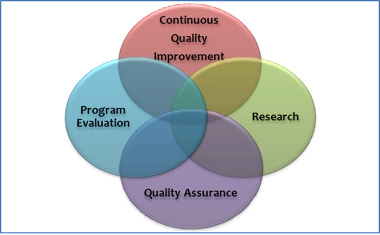Hello, I am Vanessa Hiratsuka, secretary of the Alaska Evaluation Network (AKEN) and a senior researcher at Southcentral Foundation (SCF), a tribally owned and managed regional health corporation based in Anchorage, Alaska, which serves Alaska Native and American Indian people.
As part of Commitment to Quality, a key organizational value, Southcentral Foundation (SCF) prioritizes continuous quality improvement (CQI), quality assurance, program evaluation, and research.
Although the strategies and tools used in CQI, quality assurance, program evaluation, and research are similar, we do different things. One of our challenges is to help staff across the organization understand who does what. Because these four fields differ in aim and audience, exploring the goals of a project (aim) and who will use its findings (audience) provides a useful framework to determine where a project fits.
At SCF, improvement staff work directly with SCF department and clinic processes to develop and implement project performance measures and outcome indicators as well as help staff (audience) improve processes to better meet customer-owner needs and inform business directions (aim). Quality Assurance staff conduct quality monitoring to ensure programs are complying (aim) with SCF processes and the requirements of our accrediting bodies (internal and external audiences).
SCF internal evaluators measure programs’ performance (aim) and provide feedback to programmatic stakeholders — including staff, leadership, and funders (audience). The SCF research department’s projects address questions of clinical significance to contribute to generalizable knowledge (aim) for use within SCF and for dissemination in the scientific literature around American Indian and Alaska Native health (audience).
Lessons Learned:
– Define the aim and intended audience early in the process! This helps identify the stakeholders, level of review, and oversight needed during all stages of a project, including development, implementation, and dissemination of findings.
– Broadly disseminate findings! Findings and recommendations from all disciplines are only useful when they are shared. At SCF, findings are shared at interdivisional committee meetings and with staff who oversee the work of departments. Multipronged dissemination ensures involvement from all levels of SCF and supports innovation and the spread of new knowledge.
– Project review can be complicated! At SCF, research projects must be vetted through a tribal concept review phase, an Institutional Review Board review, and finally a tribal review of the proposal. Later, all research dissemination products (abstracts for presentation, manuscripts, and final reports) are also required to undergo a tribal research review process. These take time, so it is important to understand the processes and timelines and build review time into your project management timelines.
Check out these posts on understanding evaluation:
- 1. Gisele Tchamba on Learning the Difference between Evaluation and Research
- 2. John LaVelle on Describing Evaluation
The American Evaluation Association is celebrating Alaska Evaluation Network (AKEN) Affiliate Week. The contributions all this week to aea365 come from AKEN members. Do you have questions, concerns, kudos, or content to extend this aea365 contribution? Please add them in the comments section for this post on the aea365 webpage so that we may enrich our community of practice. Would you like to submit an aea365 Tip? Please send a note of interest to aea365@eval.org. aea365 is sponsored by the American Evaluation Association and provides a Tip-a-Day by and for evaluators.


Hello,
I realize I am several years late for this post but find it very fitting as my team is trying to delineate our work between CQI, QA, program evaluation, and research. I’m finding it difficult to identify resources defining these four concepts in one space. Do you by chance have a document you could share with definitions of each as used in your organization?
Thank you!
Maria